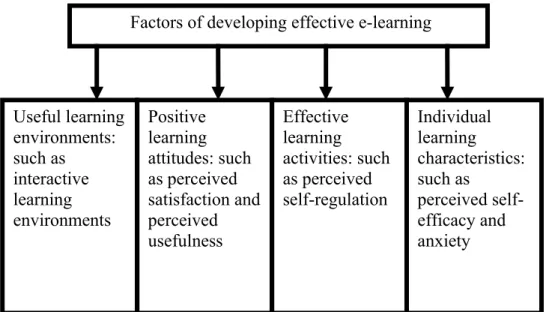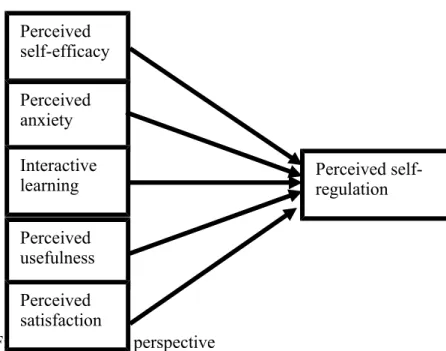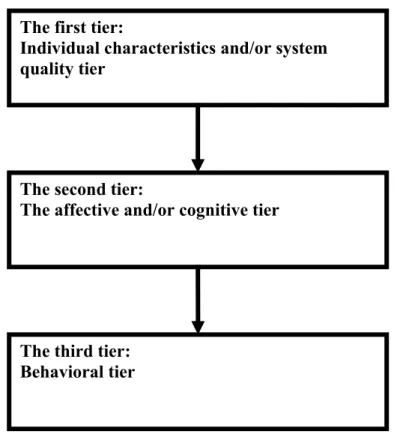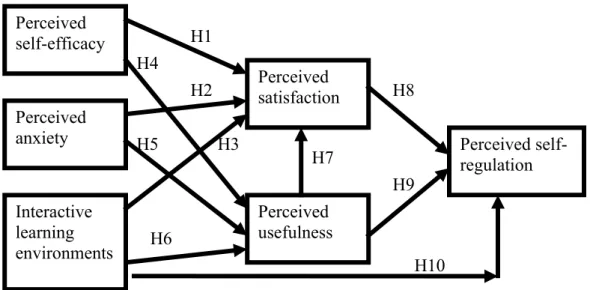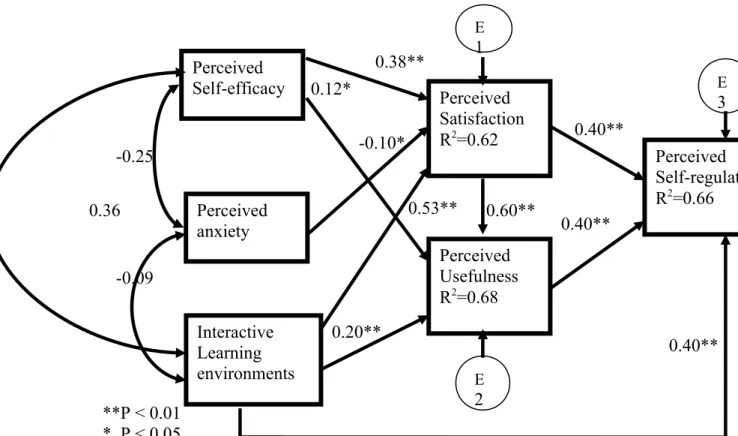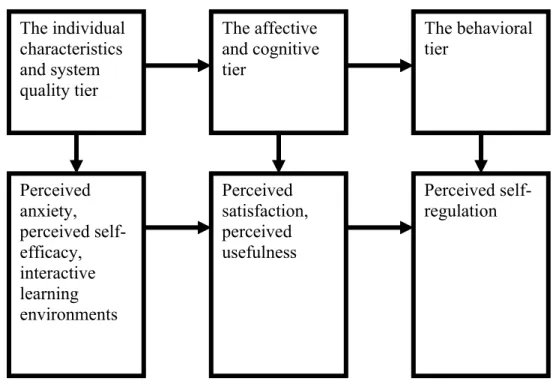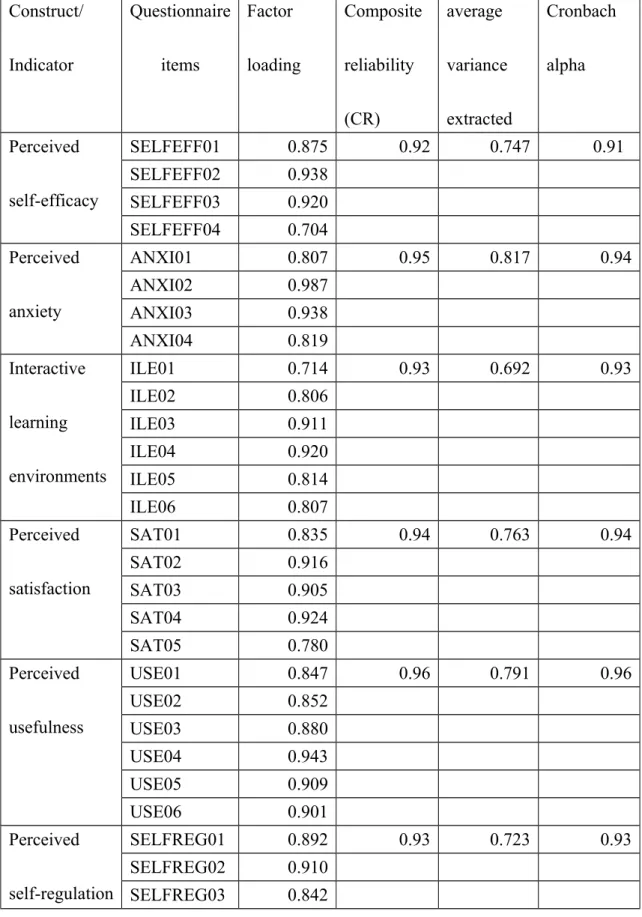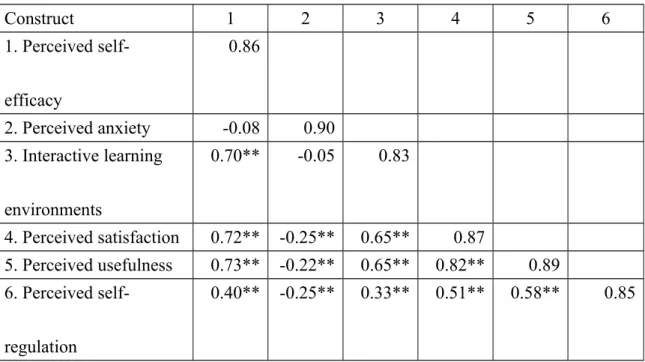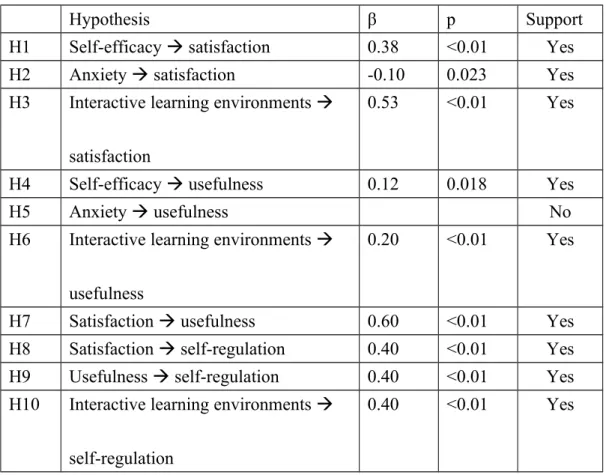Perceived satisfaction, perceived usefulness and interactive learning environments as predictors to self-regulation in e-learning environments
Shu-Sheng Liaw
General Education Center, China Medical University 91 Shiuesh Rd., Taichung, 404, Taiwan
E-mail: ssliaw@mail.cm u .edu.tw ,Phone: 886-4-22053366 Ext. 6319
Hsiu-Mei Huang
Department of Information Management, National Taichung Technology University, 129, Sec. 3, Saming Rd., Taichung, 404, Taiwan
Abstract
The research purpose is to investigate learner self-regulation in e-learning environments. To better understand learner attitudes toward e-learning, 196 university students answer a questionnaire survey after use an e-learning system few months. The statistical results showed that perceived satisfaction, perceived usefulness, and interactive learning environments toward e-learning were all found to predict perceived self-regulation. Further, perceived usefulness toward e-learning can be influenced by interactive learning environments, perceived self-efficacy, and perceived satisfaction. In addition, perceived satisfaction can be predicted by
interactive learning environments, perceived self-efficacy, and perceived anxiety. At last, the study proposes a conceptual model to better understand learner
self-regulation in e-learning environments.
1. Introduction
E-learning is one of the most promising applications of network and information technologies, and represents the most recent evolution of distance learning—a learning situation in which instructors and learners are separated by distance, time, or both (Raab, Ellis & Abdon, 2002). E-learning is a web-based system that makes information or knowledge available to learners regardless of time
restrictions or geographic proximity, and the learning environment is emerging as the new paradigm in modern education. This approach to learning expands the scope of vertical interaction, between learners and instructors, and horizontal interaction among learners, removing limitations of time and space through the use of asynchronous and synchronous learning tools; thus satisfying the educational requirements of modern society and greatly expanding demand for higher education (Sun, Tsai, Finger, Chen &Yeh, 2008). In other words, e-learning uses network technologies to create, foster, deliver, and facilitate learning anytime and anywhere.
During the past 20 years of Web technology development, e-learning systems have been widely used in higher education (Kim & Bonk, 2006). As the use of e-learning has increased, so has research into those factors affecting learners’ attitudes toward e-learning (Lee, Tseng, Liu & Liu, 2007; Wang, 2003). Although the benefits of e-learning have been discussed in various previous studies; these benefits are a
critical aspect of learners’ perception of the value of their e-learning experience. Previous research done under different task environments has suggested a variety of factors affecting user attitudes toward e-learning. Although these studies have suggested a variety of factors affecting learner attitudes toward e-learning, few of them discussed learner self-regulation. Based on learner attitudes, this research is to investigate learner self-regulation toward e-learning.
As e-learning environments have grown, so too has scholarly interest in students’ self-regulation toward e-learning. Self-regulating learners are characterized as committed participants who efficiently control their own learning activities in various ways, including organizing and rehearsing learning content to be learned, monitoring their learning processes, and holding positive motivational beliefs about their capabilities and the value of learning (Artino & Stephens, 2009). Self-regulated learning has been defined as an active, constructive process whereby learners set goals for their learning based on past experiences and the contextual features of the current environment (Pintrich, 2000). Thus, the benefits of self-regulated learning are a critical aspect of understanding learner self-regulation in e-learning.
The remainder of this paper is organized as follow: Section 2 describes factors involved in developing effective e-learning. Section 3 proposes our research
and the presentation of discussion and conclusion in Section 5. 2. Literature review
2.1. E-learning
Sharples (2000) suggests that the advances in instructional methodology have set the stage for a successful learning environment. As learning has become more individualized, learner-centered, situated, collaborative, and ubiquitous, technology has become more personalized, user-centered, networked, ubiquitous, and durable (Motiwalla, 2007). Sharples posits that learning technology, such as those which make e-learning possible, provides four approaches for enhancing learning: Intelligent tutoring systems offer value-added knowledge; simulation and modeling tools serve as learners’ assistants; system tools or resources, such as learning organizers, concept maps, or learning planners, aid learners in organizing knowledge; and personalized communication aids (Sharples, 2000).
Bouhnik and Marcus (2006) state five advantages for e-learning: The freedom to decide when each lesson will be learned, reduced time constraints on the lecturer, the freedom to express thoughts and ask questions is without limitations, the manner in which the content is presented makes it convenient to review lessons previously learned, and the accessibility of the course’s subject matter and related materials which the student may explore at his own election. Besides, Capper (2001) also
program at any convenient time), any place (participants do not have to meet in person), asynchronous interaction (interactions can be more succinct and to-the-point, discussion can stay more on-track, and people can get a chance to craft their
responses), group collaboration(electronic messaging creates new opportunities for groups to work together by creating shared electronic conversations and discussions), and new educational approaches (online courses have allowed for the economic feasibility to many new options and learning strategies).
Despite these perceived benefits of e-learning, and notwithstanding the growth of the e-learning market in recent years, researchers have indicated e-learning courses suffer from a high rate of attrition (Dutton & Perry, 2002). Responses from e-learning participants may provide a better understanding of why students are often dissatisfied with their e-learning experiences. Bouhnik and Marcus (2006) found five sources of student dissatisfaction with e-learning: a firm framework to encourage students to learn is lacking, learning requires a high level of self-discipline or self-direction, e-learning systems frequently fail to establish an atmosphere conducive to e-learning, the learning process is less efficient than conventional modes of instruction, and the distance-learning format minimizes the level of contact and discussion among
students, resulting in a lack of interpersonal and direct interaction among students and teachers. These factors require e-learning students to dedicate more time and effort to
their learning than students in conventional classroom settings.
To improve e-learning outcomes, Liaw and Huang (2007) suggested that four elements should be considered when developing e-learning environments:
environmental characteristics, environmental satisfaction, learning activities, and learners’ characteristics. Environmental characteristics, such as synchronous or asynchronous interaction, can be used to create a high-level communicative e-learning environment that allows learners not only to share information, but also to retrieve useful information. In addition, learners frequently have negative towards unfamiliar technologies. Raising environmental satisfaction improves learner perception of the relevant technology, thus potentially promoting participation in the learning
processes. Moreover, useful learning activities, such as self-regulated activities, provide a great chance for learners and instructors to share their knowledge and experience. Furthermore, Shee and Wang (2008) suggested for evaluating web-based e-learning systems, four dimensions should be investigated: learner interface, learning community, system content, and personalization. Learner interface is such as ease of use, user-friendly, and operational stability. In this dimension, positive learning attitudes could enhance e-learning performance. Learning community, it could be referred as learning activities, is like as interaction with other learners or teachers, sharing information, and exchanging learning experience. System content is related to
useful, satisfied and sufficient learning content. In other words, useful learning content or environments may assist learning effects. Personalization, is a kind of learner characteristics, includes capability of self-regulation activities and capability of controlling learning progress.
Therefore, based on previous studies (Bouhnik & Marcus, 2006; Capper, 2001; Dutton & Perry, 2002; Liaw & Huang, 2007; Motiwalla, 2007; Shee & Wang, 2008), the following are identified as factors in the development of effective e-learning environments: useful e-learning environments, positive e-learning attitudes, effective learning activities, and individual learning characteristics. Figure 1 presents these factors.
---Insert Figure 1 here---2.2 Learner self-regulation toward e-learning
Recently, considerable interest has been devoted to the role of self-regulated learning in education. Several researchers and educators have identified the importance of self-regulation as a crucial predictor of academic success. Indeed, educational research has focused on students’ self-regulated learning skills for the successful acquisition of knowledge. Pintrich (2000, p. 453) defines self-regulated learning as ‘‘an active, constructive process whereby learners set goals for their learning and then attempt to monitor, regulate, and control their cognition, motivation, and behavior, guided and constrained by their goals and the contextual features of the
environment”. Ruohotie (2002) believes that self-regulated learners are better able to direct new efforts in their learning processes. In other words, self-regulated learners are those who “direct their learning processes and attainments by setting challenging goals for themselves…, by applying appropriate strategies to achieve their goals…and by enlisting self-regulative influences that motivate and guide their efforts” (Zimmerman & Bandura & Martinez Pons 1992, p. 664). Therefore, self-regulated learners are more active participants in the learning process and are basically more effective learners. Although self-regulated learners are more meta-cognitively, motivationally, and behaviorally active participants in their own learning processes (Kramarski & Gutman, 2006;
Zimmerman & Schunk, 2001); however, some other studies have indicated that few students are skilled at regulating their learning to optimize the outcomes of self-directed learning (Azevedo & Cromley 2004).
Recent advances in technology have brought both opportunities and challenges. A high degree of self-regulation leads to greater engagement with information system. Information systems can provide flexible interaction and
communication to enhance social communication, thus potentially making e-learning a powerful self-regulated learning tool for promoting successful learning outcomes. Previous studies have found that students learn little in e-learning environments and fail to use key self-regulatory processes and mechanisms during learning, such as
effective cognitive and meta-cognitive strategies (Azevedo & Cromley 2004; Hadwin & Winne 2001). E-learning environments provide students with dynamic, interactive nonlinear access to a wide range of information represented as text, graphics,
animation, audio, and video, as well as to self-directed learning in online communication environments such as hypertext, e-mail and discussion forums (Kramarski & Gutman, 2006; Vighnarajah, Wong & Kamariah, 2009).
Indeed, with the explosion of e-learning, educators and researchers alike have come to understand that highly-motivated, self-regulated learners are most likely to be successful in e-learning. The need for high level of self-regulation is due, in part, to the relatively autonomous nature of e-learning environments compared to that of traditional classroom settings. Dabbagh and Kitsantas (2004) suggested that learners need to exercise a high degree of self-regulation to accomplish their learning goals in e-learning environments. Furthermore, self-regulated learners are more inclined to successfully transfer knowledge from e-learning environments into real-world situations. Previous studies also have indicated that students who lack good self-regulation are not as academically successful (Zimmerman & Schunk, 2001), while successful learners are more likely to be self-regulating. Therefore, the most
important task for instructional designers and educators is to develop effective
and self-regulated learners.
But what kinds of factors could influence self-regulation. Sharma, Dick, Chin, and Land (2007) stated that learners should possess the following self-regulatory attributes to enhance learning capability: first, motivation in terms of goal orientation, second, learner self-efficacy, third, environment management, and fourth, interaction for help seeking. Based on e-learning perspective, for developing effective e-learning
environments, motivation is a kind of positive learning attitudes that can be viewed as intrinsic motivation (perceived satisfaction) and extrinsic motivation (perceived usefulness). Learner self-efficacy is a positive individual characteristic while learner anxiety is a negative individual characteristic. Interactive learning environment is a powerful learning environment that could assist environment management for help seeking. Therefore, from Figure 1 perspective, effective learning activity, such as perceived self-regulation, could be affected by other factors: individual
characteristics, intrinsic and extrinsic motivation, and useful learning environment. Thus, our research perspective is shown as Figure 2. Based on Figure 2, the
independent factors that could influence dependent factor (perceived self-regulation) are perceived self-efficacy, perceived anxiety, perceived satisfaction, perceived usefulness, and interactive learning environment. Our research perspective is based on Figure 2.
---Insert Figure 2
her--2.3 Perceived interaction, usability, satisfaction, self-efficacy, and anxiety toward e-learning
2.3.1 Interactive learning environments
E-learning systems encompass communication and exploration activities. Communication activities involving e-mail, chat forums, online conferences, and blogs are all appropriate for asynchronous and synchronous social communication. By contrast, exploration activities involve Web browsers are good for interacting with content. In essence, an e-learning environment offers the following different types of interaction, such as learning content interaction, learner-learner communication, and learner-instructor communication.
Given its nonlinear media form, an e-learning system allows learners to autonomously explore abundant and diverse bits of information. In an e-learning system, learners conduct social and interpersonal interaction through computer networks and interfaces rather than through face-to-face communication. In some important ways, e-learning systems offer greater potential for social and interpersonal communication than is possible through face-to-face interaction. In an e-learning system, communication (e.g., questioning, answering, discussing, debating,
negotiating, etc.) can occur online both vertically between learner and teacher, and horizontally among learners (Liaw, 2004).
In e-learning, asynchronous communication is technologically mediated and is not dependent upon instructors and learners being simultaneously active to conduct teaching and learning activities (Liaw, 2004). In asynchronous communication, learners work at their own convenience and control the pace of instruction.
Synchronous communication occurs in real time, requiring instructors and learners to be simultaneously available for interaction, although not necessarily in the same physical location. In this context, online chat used for oral discussion enhances the quality and creativity of thought and argument.
2.3.2 Perceived usability and satisfaction
Information system research clearly shows that learner usage and learner
satisfaction are essential factors in assessing the success of learning systems (Delone & Mclean, 2003; Lewis, 2002; Virvou & Katsionis, 2008). Essentially, evaluation of educational software is mainly concerned with the pure educational effects of the software. However, in most cases, usability is considered to be an important factor affecting educational effectiveness (Virvou & Katsionis, 2008). Usability is a quality or attribute that represents the ease of use of human–computer interfaces (Kneebone, 2003). The international standard ISO 9241 provides guidance on usability and defines it as “the extent to which a product can be used by specified users to achieve specified goals with effectiveness, efficiency and satisfaction in a specified context of
use”. Because usability is a complex multidimensional concept, various methods have been proposed to measure it. Ideally, usability measures how actual users use the product in an authentic context. The concept of usability is somewhat situation-dependent in that the characteristics of the learning environment or learning context influence usability (Yoon, Laffey & Oh, 2008).
Satisfaction can be defined as user acceptance of information systems and the degree of comfort involved in using them. It can also be defined as the pleasure or contentment one feels when s/he performs a required or desired action and
experiences the result (Shee & Wang, 2008). Satisfaction is positively conceptualized as the aggregate of a person’s feelings or attitudes towards the many factors that affect a certain situation. Operating from an information system perspective, Doll and Torkzadeh (1988) defined satisfaction as the condition of taking an affective attitude toward a given system. Thus a greater degree of satisfaction toward an information system implies a higher degree of willingness to use it. In the field of human-computer interaction, user satisfaction is usually visualized as the expression of affection gained from interaction. This means that user satisfaction is the ‘‘subjective sum of interactive experiences’’ influenced by many affective components in the interaction (Lindgaard & Dudek, 2003). Additionally, in the field of information systems the concept of user satisfaction is usually used to represent the degree to
which users believe a system satisfies their usage requirements.
In the past, many attempts have been made to measure user satisfaction, with results revealing that user satisfaction is a complex construct and its substance varies with the nature of the experience or case. For example, in an e-learning system, user satisfaction is significantly influenced by system quality, system usability and content quality (Kim & Ong, 2005). Other research suggests that the use of rich media with more interactive functions can enhance learner satisfaction (Liu, Liao & Pratt, 2009). Roca and Gagne (2008) suggested three critical factors for learner satisfaction: autonomy, competence, and relatedness.
2.3.3 Perceived self-efficacy
The self evaluation of competence in education is frequently discussed in terms of perceived self-efficacy (Bandura, 1997), which refers to the degree to which an individual is confident that s/he can perform a specific task or achieve a specific goal (Bandula, 1997). This confidence, or lack thereof, has an influence on choice of activities, degree of effort expended, and persistence of effort. Indeed, perceived self-efficacy is the learner’s belief that her/his performance can be improved through achievement-related behavior. Self-efficacy refers to “beliefs in one’s capabilities to organize and execute the course of action required to produce given attainments’’ (Bandula, 1997). Furthermore, perceived self-efficacy can be viewed as a prerequisite
to use, but successful interactions with technology are also viewed as influencing self-efficacy. Bandura (1986) defined self-efficacy as "generative capability in which cognitive, social, and behavioral subskills must be organized into integrated courses of action to serve an innumerable purpose" (p.391). This definition highlights a key aspect of the self-efficacy construct.
Perceived self-efficacy could be correlated with achievement-related behaviors such as skills performance, motivation, and choice of activities (Bandura, 1986). Given serious uncertainties regarding performance of necessary activities, efficacy expectations would no longer impact behavior. Thus, people who perceive themselves as self-efficacious will persist in their efforts longer and more actively. Kinzie, Delcourt, and Powers (1994) defined self-efficacy as an individual's confidence in her/his ability to perform the behavior required to produce specific outcomes. Self-efficacy thus has a direct impact on the choice to engage in a task, the effort expended and the persistence exhibited. Additionally, Murphy, Coover, and Owen (1989) stated that computer self-efficacy is an individual's perception of her/his capability regarding specific computer knowledge and skills. Previous studies have suggested that a higher degree of perceived self-efficacy leads to improved learning performance and better behavioral retention in e-learning environments (Chu & Chu, 2010; Liaw, 2008; Torkzadeh, Chang, & Demirhan, 2006). In other words, learner efficacy influences
the individual’s ability to acquire skills, choice of activities, and willingness to continue in a course of action.
2.3.4 Perceived anxiety
Perceived anxiety refers to an unpleasant emotional state or condition
characterized by tension, apprehension, and worry (Spielberger, Gorsuch & Lushene, 1970). General feelings of anxiety have been associated with broad work-related outcomes, such as stress and feelings of work overload (Ganster & Schauebrock, 1991), as well as beliefs about one’s ability (Ghiselli, Campbell & Zedeck, 1981). Computer anxiety is characterized as an affective response, and has been defined as a fear of using computers (Chua, Chen, & Wong, 1999), specifically an emotional fear of potential negative outcomes such as damaging the equipment or appearing foolish. From an information-processing perspective, the negative feelings associated with high levels of anxiety divert cognitive resources from task performance (Kanfer & Heggestad, 1997). Thus, the performance of participants with a high degree of computer anxiety might be poorer than those with little or no computer anxiety. A number of studies using a broad range of samples have explored the relationship between computer anxiety and Internet use, and found that computer anxiety was negatively related to students’ use of the Internet (Barbeite & Weiss, 2004; Durndell & Haag, 2002).
Internet anxiety is the fear or apprehension that individuals experience when using the Internet (Presno, 1998). The Internet may evoke anxiety because it requires users to learn new terminology and understand unfamiliar applications. In addition, the Internet may raise a range of emotions because it results in interaction with unknown situations or people. Furthermore, using the Internet presents risks, such as the potential for exposure viruses and spyware, or invasions of user privacy (Barbeite & Weiss, 2004). Internet anxiety hinders individuals’ use of e-mail, instant
messaging, or on-line databases. Because of its effect on behavior, it must be managed to create more opportunities for all to reap the benefits of the Web
(Thatcher, Loughry, Lim, & McKnight, 2007). Various studies have investigated the relationship between Internet anxiety and Internet use, finding that computer anxiety was negatively correlated to students’ use of the Internet (Chou, 2003; Joiner, Brosnan, Duffield, Gavin, & Maras, 2007).
3. Research Hypotheses
Understanding learner attitudes toward e-learning is a critical issue for improving learning usage and effects. In other words, investigating user attitudes toward e-learning could facilitate the creation of appropriate e-e-learning environments for teaching and learning. Evaluating methods of e-learning assessment cannot be performed using a single linear methodology, and collecting data on individual
attitudes towards e-learning requires a multidisciplinary approach (Liaw, 2004, 2008; Wang, 2003). The measurement of what aspects of e-learning must incorporate different aspects of user perceptions to form a useful diagnostic instrument (Wang, 2003).
Based on the Liaw’s (2008) research, individual attitudes toward e-learning can be divided three different tiers: the individual characteristics (or experience) and system quality tier, the affective and cognitive tier, and the behavioral tier (Figure 3). The individual characteristics and system quality tier evaluates how individual
characteristics and system quality affect individual affective and cognitive factors. The affective and cognitive tier investigates how affective and cognitive factors influence individual behavioral intentions. And the behavioral tier examines how the research model can predict individual behavioral intention to use technology for a particular purpose. From the results of Liaw’s (2008) research proposed a conceptual model to investigate learner attitudes toward e-learning. The model suggests that, at the level of the individual, learner characteristics influence learner attitudes, such as perceived satisfaction and perceived usefulness. The model also shows that
environmental characteristics will affect perceived satisfaction and perceived usefulness. Furthermore, perceived satisfaction and perceived usefulness would positively affect the effectiveness of learning activities, such as the learner’s
behavioral toward to e-learning.
--- Insert Figure 3
here---Thus, two elements should be considered when facilitating e-learning satisfaction: useful environmental characteristics and individual learner
characteristics. In this study, useful environmental characteristics are interactive learning activities; individual learner characteristics are focused on learner self-efficacy and learner anxiety. We present the following hypotheses:
H1: Perceived satisfaction in e-learning will be influenced by the learner’s perceived self-efficacy.
H2: Perceived satisfaction in e-learning will be influenced by the learner’s perceived anxiety.
H3: Perceived satisfaction in e-learning will be influenced by the interactive learning environment.
Based on studies by Bouhnik and Marcus (2006), Liaw and Huang, (2007), and Motiwalla, (2007), two elements should be considered when facilitating e-learning: useful environmental characteristics and individual learner characteristics. In this study, the environmental characteristics include interactive learning activities, and learner characteristics are focused on learner self-efficacy and learner anxiety. We propose the following hypotheses:
self-efficacy.
H5: The perceived usefulness of e-learning will be influenced by perceived learner anxiety.
H6: The perceived usefulness of e-learning will be influenced by the interactive learning environment.
Efforts to measure the usability of computing systems fall into two broad
categories: objective performance measures, which measure how capable the users are of using the system, and subjective user preference or satisfaction measures, which assess how much the users enjoy the system experience (Nielsen & Levy, 1994). Both types of measures are important because, despite a strong, positive association
between capability and satisfaction, many users prefer systems that yield less satisfactory performance (Nielsen & Levy, 1994). Although users must derive some level of satisfaction with a system to be motivated to use it, successful outcomes are also a significant factor in system usability. Therefore, exploring system usability contributes to an understanding of learner satisfaction with an information system. Kim and Ong (2005) noted that perceived usability and perceived satisfaction are highly correlated, and Liaw, Chen, and Huang (2008) suggested that perceived satisfaction can increase perceptions of usability. Thus, we propose the following hypothesis:
satisfaction derived from e-learning.
Constructivist theory proposes that learning activities in which learners play active roles will engage and motivate students more effectively than passive learning activities. Individuals are assumed to learn better when they discover things by themselves and when they control the pace of learning (Leidner & Jarvenpaa, 1995). Therefore, it is natural to expect that self-regulated, interactive learning would improve learning outcomes. Many constructivists call for richer learning
environments that contrast with conventional classroom environments which rely on instructors, textbooks, and lectures, and are thus less interactive (Zhang, Zhou, Briggs, & Nunamaker, 2006). A constructivist e-learning environment should thus enable learners to engage in interactive communication and self-regulated activities during knowledge construction. Previous studies state that increased perceived
satisfaction and usability can increase learner self-regulation in e-learning (Kramarski & Gutman, 2006). We propose the following hypotheses:
H8: Perceived self-regulation in e-learning will be influenced by perceived satisfaction.
H9: Perceived self-regulation e-learning will be influenced by perceived usability. H10: Perceived self-regulation learning will be influenced by the interactivity of e-learning e-learning environments.
---Insert figure 4 here---4. Methodology
4.1 Participants
This research is conducted by using the iCAN e-leaning system, for which the major system functions include: homepage, teaching/learning materials,
discussion board, and homework assignment. The iCAN homepage provides overall course information including syllabus, textbook information, assessment, and other information related the course. Learners have continuous anytime/anywhere access to teaching/learning materials, in the form of PowerPoint slides, MS Word, Acrobat PDF documents, and video files. On the discussion board, instructors can post instructions on how to prepare for an upcoming lecture and while students can post their questions about assignments or technical issues. The homework assignment function allows students to directly submit their completed assignments to the instructor for evaluation.
To better understand learners’ attitudes toward iCAN e-learning, a
questionnaire was distributed to 220 randomly-selected university students who had been using the system for three months. The questionnaire collected demographic information and posed questions related to the respondent’s e-learning experience, and attitude toward e-learning. The paper-based questionnaires were distributed with
discarded due to incomplete responses, leaving 196 valid responses. 4.2 Measurement
The questionnaire was revised from Liaw’s (2008) highly reliable (α = 0.97) survey questionnaire, and covered the following:
Demographic information: Gender and the field of study.
E-learning experience: Two questions in which participants were asked to indicate the extent of their experience using the Internet and e-learning systems, based on a 7-point Likert scale (1 = “no experience” to 7 = “well experienced”).
Attitudes toward e-learning: 30 questions in which participants were asked to indicate their attitudes toward e-learning, based on a 7-point Likert scale (1 = “strongly
disagree” to 7 = “strongly agree”). Appendix A is questionnaire items. 5. Results
In analyzing the collected data from the survey, we followed the two-step
procedure suggested by Anderson and Gerbing (1988). The reliability and validity of the measurement instrument was first evaluated by calculating Cronbach’s α to measure internal consistency (α = 0.95). We then examined the structural model to determine the strength and direction of the relationships among the theoretical constructs.
5.1. Analysis of the measurement model
estimated coefficient was significant on its posited underlying construct factor. We evaluated the measurement scales based on Fornell and Larcker’s (1981) three criteria: all indicator factor loadings (k) should be significant and exceed 0.5, construct reliabilities should exceed 0.8, and average variance extracted (AVE) by each construct should exceed the variance due to measurement error for the construct (e.g., AVE should exceed 0.5).
The Cronbach’s alpha scores, shown in Table 1, indicated that each construct exhibited strong internal reliability, with all standard factor loading (k) values in confirmatory factor analysis of the measurement model exceeding 0.5 and significant at p = 0.001. In addition, the composite reliabilities of constructs ranged from 0.92 to 0.6; the AVE, ranging from 0.692 to 0.817, was greater than the variance due to measurement error. In this research, all three conditions for convergent validity met the criteria.
---Insert Table 1
here---Discriminant validity can assess the extent to which a concept and its indicators differ from another concept and its indicators. According to the criteria proposed by Fornell and Larcker (1981), correlations between items in any two constructs should be lower than the square root of the average variance shared by items within a construct. The square root of the variance shared between the construct
and its items was greater than the correlations between the construct and any other construct in the model (as shown in Table 2), satisfying the criteria for discriminant validity. All diagonal values exceeded the inter-construct correlations, and the results confirmed that our instrument had satisfactory construct validity.
---Insert Table 2 here---5.2. Analysis of the structural model
The full structural model of the hypothesized relationships was statistically tested using AMOS 6.0, a software package designed to perform a structural equation model approach to path analysis using maximum likelihood estimation. To analyze the structural model we assessed the overall goodness-of-fit using the chi-square test, which assesses the adequacy of a hypothesized model in terms of its ability to reflect the variance and covariance of the data. Due to the chi-square test’s sensitivity to sample size, other fit indices (namely GFI, CFI, and NFI) were considered as well. The results of structural equation modeling obtained for the proposed conceptual model revealed of chi-square of 43.735 (p < 0.001), goodness-of-fit index (GFI) of 0.937, comparative fit index (CFI) of 0.937, normed fit index (NFI) of 0.934, and root mean square error of approximation (RMSEA) of 0.264. Generally, fit statistics greater than or equal to 0.9 for GFI, NFI, and CFI indicate a good model fit (Anderson & Gerbing, 1988).
The ten hypotheses were tested collectively using the structural equation modeling (SEM) approach. We examined the path significance of each hypothesized association in the research model and variance explained (R2 value) by each path, and Figure 5
and Table 3 respectively show the standardized path coefficients and path
significances. In this research, six hypothesized associations were strongly significant at p < 0.01, two hypothesized associations were significant at p < 0.05, and one hypothesis was not significant (perceived anxiety to perceived usefulness). Consistent with H1-H3, perceived self-efficacy was positively related to perceived satisfaction (β = 0.38, p < 0.01), perceived anxiety was negatively related to perceived satisfaction (β = -0.10, p < 0.05), and interactive learning was positively related to perceived
satisfaction (β = 0.53, p < 0.01). Regarding to H4-H6, perceived self-efficacy was positively related to perceived usefulness (β = 0.12, p < 0.05), and interactive learning was positively related to perceived usefulness (β = 0.20, p < 0.01). However,
perceived anxiety could not predict perceived usefulness. Regarding H7, perceived satisfaction was positively related to perceived usefulness (β = 0.60, p < 0.05). Consistent with H8-H10, the perceived self-regulation of using e-learning was jointly predicted by perceived satisfaction (β = 0.40, p < 0.001), perceived usefulness (β = 0.40, p < 0.01), and interactive learning environments (β = 0.40, p < 0.01), and these three variables together explained 66% of the variance (R2 = 0.66).
---Insert Figure 5 ---Insert Table 3 here---6. Discussions and conclusions
Based on our research hypotheses, perceived satisfaction toward e-learning can be predicted by interactive learning environments, perceived self-efficacy, and perceived anxiety toward e-learning. Perceived usefulness toward e-learning can be influenced by interactive learning environments and perceived self-efficacy toward e-learning. In addition, perceived satisfaction toward e-learning is a predictor of the perceived usefulness of e-learning. Perceived satisfaction, perceived usefulness, and interactive learning environments toward e-learning were all found to predict perceived self-regulation in e-learning.
From the theoretical research model, individual attitudes toward information technology can be divided into three different tiers. The individual characteristics and system quality tier can influence the affective and cognitive tier, while the affective and cognitive tier can affect the behavioral intention tier. Based on statistical analysis, our research results support the theoretical research model and, based on those results, the individual characteristics and system quality tier include perceived anxiety, perceived self-efficacy, and the use of interactive learning environments. The affective and cognitive tier includes perceived satisfaction and perceived usefulness, while the behavioral tier is perceived self-regulation. Therefore, we propose a
conceptual model as shown in Figure 6.
---Insert Figure 6
In recent years, learning modes have experienced a revolution due to the rapid growth of e-learning technologies. In conventional classroom learning, learners basically play a passive role as teachers convey knowledge to them. Since learners are highly reliant on instruction from the teacher to acquire knowledge, most learners may lose the ability to self-regulate. Previous studies have indicated that students who are not capable of self-regulation are not as academically successful (Chen, 2009), whereas good self-regulators can monitor, regulate, and control their cognition, motivation, and behavior, as guide and constrain by their goals.
Four factors should be simultaneously considered in the development of e-learning systems: individual learner characteristics, useful environmental characteristics, positive learner attitudes, and effective learning activity. Our results indicate that learning activity (e.g., perceived self-regulation) could be affected by environmental characteristics (e.g., interactive learning environments), environmental satisfaction (e.g., perceived satisfaction and perceived usefulness), and learner characteristics (e.g., perceived anxiety and perceived self-efficacy). In other words, when developing self-regulated e-learning environments, we should consider learners’ personal
satisfaction and usefulness.
One natural extension of this research is to identify factors that affect individual self-regulation toward e-learning environments. Fundamentally, there is no single and universally accepted conceptual model for evaluating individual self-regulation in e-learning environments. This study provides a new approach to understanding user attitudes toward e-learning environments. In trying to improve learning outcomes of learning, future research should investigate the effects of self-regulation on e-learning effectiveness.
References:
Artino, A. R., & Stephens, J. M. (2009). Academic motivation and self-regulation: A comparative analysis of undergraduate and graduate students learning online. Internet and Higher Education, 12, 146-151.
Azevedo R., & Cromley J.G. (2004) Does training of self-regulated learning facilitate student’s learning with hypermedia? Journal of Educational Psychology, 96,
523–535.
Bandura, A. (1986). Social Foundations of Thought and Action, Prentice Hall, Englewood Cliffs, NJ.
Bandura, A.(1997). Self-Efficacy: The Exercise of Control, W.H. Freeman, New York, 1997.
Barbeite, F.G., & Weiss, E.M. (2004). Computer self-efficacy and anxiety scales for an Internet sample: testing measurement equivalence of existing measures and development of new scales. Computers in Human Behavior, 20(1), 1-15.
Bouhnik, D., & Marcus, T. (2006). Interaction in distance-learning courses. Journal of the American Society Information Science and Technology, 57(3), 299–305. Capper, J. (2001). E-learning growth and promise for the developing world. TechKnowLogia. Available at: http://www.techknowlogia.org. Retrieved July 20, 2007.
mechanisms for promoting learning performance. Expert System with applications, 36, 8816-8829.
Chou, C. (2003). Incidence and correlates of Internet anxiety among high school teachers in Taiwan. Computers in Human Behaviors, 19, 731–749.
Dabbagh, N. & Kitsantas, A. (2004). Supporting self-regulation in student-centered Web-based learning environments. International Journal on E-Learning, 3(1), 40-47. Delone,W. H., & Mclean, E. R. (2003). The Delone and Mclean model of information systems success: a ten-year update. Journal of Management Information Systems, 19(4), 9–30.
Doll, W. J., & Torkzadeh, G. (1988). The measurement of end-user computing satisfaction. MIS Quarterly, 12(2), 259–274.
Durndell, A., & Haag, Z. (2002). Computer self efficacy, computer anxiety, attitudes towards the Internet and reported experience with the Internet, by gender, in an East European sample. Computers in Human Behaviors, 18(4), 521–535.
Ganster, D.C., & Schauebrock, J. (1991). Work stress and employee health. Journal of Management, 17 (2), 235–271.
Ghiselli, E.E., Campbell, J.P., & Zedeck, S. (1981). Measurement Theory for the Behavioral Science, W.H. Freeman, San Francisco, CA.
Hadwin A. & Winne P. (2001) CoNoteS2: a software tool for promoting self-regulation. Educational Research and Evaluation, 7, 313–334.
Joiner, R., Brosnan, M., Duffield, J., Gavin, J., & Maras, P. (2007). The relationship between Internet identification, Internet anxiety and Internet use. Computers in Human Behavior, 23, 1408-1420.
Kinzie, M. B., Delcourt, M. A. B., & Powers. S. M. (1994). Computer Technologies: Attitudes and Self-Efficacy across Undergraduate Disciplines, Research in Higher Education, 35, 745-768.
Kneebone, R. (2003). Simulation in surgical training: educational issues and practical implications, Medical Education, 37, 267–277.
Kim, K.J. & Bonk, C. J. (2006). The future of online teaching and learning in higher education: the survey says ... . Educause Quarterly, 29, 22–30.
Kim, G. M., & Ong, S. M. (2005) An exploratory study of factors influencing M-learning. Journal of Computer Information Systems, 92-98.
Kramarski, B., & Gutman, M. (2006). How can self-regulated learning be supported in mathematical E-learning environments? Journal of Computer Assisted Learning, 22, 24-33.
Lee, Y. K., Tseng, S. P., Liu, F. J. & Liu, S. C. (2007). Antecedents of learner satisfaction toward e-learning. The Journal of American Academy of Business, Cambridge, 11, 161–168.
Lewis, C. (2002). Driving factors for e-Learning: an organizational perspective. Perspectives, 6(2), 50–54.
Liaw, S. S. (2004). Considerations for developing constructivist Web-based learning. International Journal of Instructional Media. 31(3). 309-321.
Liaw, S. S. (2008). Investigating students’ perceived satisfaction, behavioral intention, and effectiveness of e-learning: A case study of the Blackboard system. Computers & Education, 51(2), 864-873.
Liaw, S. S., Chen, G. D., & Huang, H. M. (2008). Users’ attitudes toward Web-based collaborative learning systems for knowledge management. Computers & Education, 50, 950-961.
Liaw, S. S., & Huang, H. M. (2007). Developing a Collaborative e-learning System Based on Users’ Perceptions. Lecture Notes in Computer Science, 4402, 751-759. Lindgaard, G., & Dudek, C. (2003). What is this evasive beast we call user satisfaction? Interacting with Computers, 15(3), 429–452.
Liu, S H., Liao, H. L., & Pratt, J. A. (2009). Impact of media richness and flow on e-learning technology acceptance. Computers & Education, 52, 599–607.
Motiwalla, L. F. (2007). Mobile learning: a framework and evaluation. Computers & Education, 49(3), 581-596.
Murphy, C. A., Coover, D., & Owen, S. V. (1989). Development and Validity of the Computer Self-Efficacy Scale, Educational and Psychological Measurement, 49, 893-899.
Communications of the ACM, 37(4), 66–75.
Pintrich, P. R. (2000). A motivational science perspective on the role of student motivation in learning and teaching contexts. Journal of Educational Psychology, 95, 667–686.
Presno, C. (1998). Taking the byte out of Internet anxiety: instructional techniques that reduce computer/Internet anxiety in the classroom. Journal of Educational Computing Research, 18(2), 147–161.
Raab, R. T., Ellis, W. W., & Abdon, B. R. (2002) . Multisectoral partnerships in e-learning: A potential force for improved human capital development in the Asia Pacific. Internet and Higher Education, 4, 217–229.
Roca, J. C., & Gagne, M. (2008). Understanding e-learning continuance intention in the workplace: A self-determination theory perspective, Computers in Human Behavior, 24, 1585–1604.
Ruohotie, P. (2002). Motivation and self-regulation in learning. In H. Niemi & P. Ruohotie (Eds.), Theoretical understandings for learning in the virtual university. Hameenlinna, Finland: RCVE.
Sharma, S., Dick, G., Chin. W. W., Land, L. (2007). Self-regulation and e-learning. Proceedings of the Fifteenth European Conference on Information System, 383-394, St. Gallen, University of St. Gallen, retrieved in Feb. 6, 2012 from
Sharples, M. (2000). The design of personal mobile technologies for lifelong learning. Computer & Education, 34, 177-193.
Shee, D. & Wang, Y. H. (2008). Multi-criteria evaluation of the web-based e-learning system: A methodology based on learner satisfaction and its applications. Computers & Education, 50, 894–905.
Spielberger, C.D., Gorsuch, R.L., & Lushene, R.E. (1970). Manual for the State-Trait Anxiety Inventory, Consulting Psychologists Press, Palo Alto, CA.
Sun, P. C., Tsai, R. J., Finger, G., Chen, Y. Y., &Yeh, D. (2008). What drives a successful e-Learning? An empirical investigation of the critical factors influencing learner satisfaction. Computers & Education, 50, 1183-1202.
Thatcher, J.B., Loughry, M.L., Lim, J., & McKnight, D.H., (2007). Internet anxiety: An empirical study of the effects of personality, beliefs, and social support.
Information & Management, 44, 353-363.
Vighnarajah, Wong, S. L., & Kamariah, A. B. (2009). Qualitative findings of students’ perception on practice of self-regulated strategies in online community discussion. Computers & Education, 53, 94-103.
Virvou, M., & Katsionis, G. (2008) On the usability and likeability of virtual reality games for education: The case of VR-ENGAGE, Computers & Education, 50, 154– 178.
learning systems. Information & Management, 41, 75–86.
Yoon, S. Y., Laffey, J., & Oh, H. (2008). Understanding Usability and User Experience of Web-Based 3D Graphics Technology. International Journal of Human-Computer Interaction, 24(3), 288–306.
Zhang, D., Zhou, L., Briggs, R. O., & Nunamaker, J. F. (2006). Instructional video in e-learning: Assessing the impact of interactive video on learning effectiveness. Information & Management, 43, 15–27.
Zimmerman B. & Schunk D. (2001) Reflections on theories of self-regulated learning and academic achievement. In Self-regulated learning and academic achievement: Theoretical perspectives, 2nd edition (eds B. Zimmerman & D. Schunk), pp. 289– 307. Erlbaum, Mahwah, NJ.
Figure 1: Factors of developing effective e-learning environments Factors of developing effective e-learning
Useful learning environments: such as interactive learning environments Positive learning attitudes: such as perceived satisfaction and perceived usefulness Effective learning activities: such as perceived self-regulation Individual learning characteristics: such as perceived self-efficacy and anxiety
Figure 2: Research perspective Perceived self-efficacy Perceived anxiety Interactive learning Perceived usefulness Perceived satisfaction Perceived self-regulation
Figure 3: Investigating learner attitudes based on three tiers The first tier:
Individual characteristics and/or system quality tier
The second tier:
The affective and/or cognitive tier
The third tier: Behavioral tier
Figure 4: Research hypotheses H10 H9 H8 H7 H6 H5 H3 H4 H2 H1 Perceived self-efficacy Perceived anxiety Interactive learning environments Perceived satisfaction Perceived usefulness Perceived self-regulation
Figure 5: The results of hypotheses Perceived Self-efficacy Perceived anxiety Interactive Learning environments Perceived Satisfaction R2=0.62 Perceived Usefulness R2=0.68 Perceived Self-regulation R2=0.66 E 1 E 2 E 3 0.36 -0.25 -0.09 0.40** **P < 0.01 **P < 0.05 0.60** 0.38** -0.10* 0.53** 0.12* 0.20** 0.40** 0.40**
Figure 6: The conceptual model of understanding self-regulation The individual characteristics and system quality tier The affective and cognitive tier The behavioral tier Perceived anxiety, perceived self-efficacy, interactive learning environments Perceived satisfaction, perceived usefulness Perceived self-regulation
Table 1: Construct validity and convergent validity Construct/ Indicator Questionnaire items Factor loading Composite reliability (CR) average variance extracted Cronbach alpha Perceived self-efficacy SELFEFF01 0.875 0.92 0.747 0.91 SELFEFF02 0.938 SELFEFF03 0.920 SELFEFF04 0.704 Perceived anxiety ANXI01 0.807 0.95 0.817 0.94 ANXI02 0.987 ANXI03 0.938 ANXI04 0.819 Interactive learning environments ILE01 0.714 0.93 0.692 0.93 ILE02 0.806 ILE03 0.911 ILE04 0.920 ILE05 0.814 ILE06 0.807 Perceived satisfaction SAT01 0.835 0.94 0.763 0.94 SAT02 0.916 SAT03 0.905 SAT04 0.924 SAT05 0.780 Perceived usefulness USE01 0.847 0.96 0.791 0.96 USE02 0.852 USE03 0.880 USE04 0.943 USE05 0.909 USE06 0.901 Perceived self-regulation SELFREG01 0.892 0.93 0.723 0.93 SELFREG02 0.910 SELFREG03 0.842
SELFREG04 0.826
Table 2: Correlation matrices and discriminant validity Construct 1 2 3 4 5 6 1. Perceived self-efficacy 0.86 2. Perceived anxiety -0.08 0.90 3. Interactive learning environments 0.70** -0.05 0.83 4. Perceived satisfaction 0.72** -0.25** 0.65** 0.87 5. Perceived usefulness 0.73** -0.22** 0.65** 0.82** 0.89 6. Perceived self-regulation 0.40** -0.25** 0.33** 0.51** 0.58** 0.85
Table 3: Summary of hypotheses tests
Hypothesis β p Support
H1 Self-efficacy satisfaction 0.38 <0.01 Yes
H2 Anxiety satisfaction -0.10 0.023 Yes
H3 Interactive learning environments satisfaction
0.53 <0.01 Yes
H4 Self-efficacy usefulness 0.12 0.018 Yes
H5 Anxiety usefulness No
H6 Interactive learning environments usefulness
0.20 <0.01 Yes
H7 Satisfaction usefulness 0.60 <0.01 Yes
H8 Satisfaction self-regulation 0.40 <0.01 Yes
H9 Usefulness self-regulation 0.40 <0.01 Yes
H10 Interactive learning environments self-regulation
Appendix A: Questionnaire Survey Construct/ Indicator Questionnaire items Questionnaire contents Perceived self-efficacy
SELFEFF01 I feel confident using e-leaning systems. SELFEFF02 I feel confident operating e-learning functions. SELFEFF03 I feel confident using online learning contents. SELFEFF04 I feel confident uploading home works and
downloading learning contents. Perceived
anxiety
ANXI01 Using e-learning let me feel bad. ANXI02 Using e-learning let me feel anxiety.
ANXI03 Using e-learning let me feel uncomfortable. ANXI04 Using e-learning let me feel nervous. Interactive
learning environments
ILE01 I would like to share my e-learning experience. ILE02 I believe e-learning can assist teacher-learner
interaction.
ILE03 I believe e-learning can assist learner-learner interaction.
ILE04 My classmates would like to share their e-learning experience.
ILE05 The e-learning interactive functions are easy to use. ILE06 The e-learning interactive functions can improve
learning performance. Perceived
satisfaction
SAT01 I am satisfied with using e-learning as a learning assisted tool.
SAT02 I am satisfied with using e-learning functions. SAT03 I am satisfied with learning contents.
SAT04 I am satisfied with multimedia instruction.
SAT05 I am satisfied with interactive e-learning functions. Perceived USE01 I believe e-learning systems are useful leaning
usefulness tools.
USE02 I believe using e-learning is effective for learning. USE03 I believe e-learning contents are informative.
USE04 I intend to use e-learning to assist my learning in the future.
USE05 I intend to use e-learning content to assist my learning.
USE06 I intend to use e-learning to improve my learning motivation.
Perceived self-regulation
SELFREG01 E-learning is a self-regulated learning tool. SELFREG02 E-learning is an active learning tool. SELFREG03 E-learning is an individual learning tool. SELFREG04 I can regulate my e-learning contents. SEFFREG05 The e-learning contents are easy to regulate.
